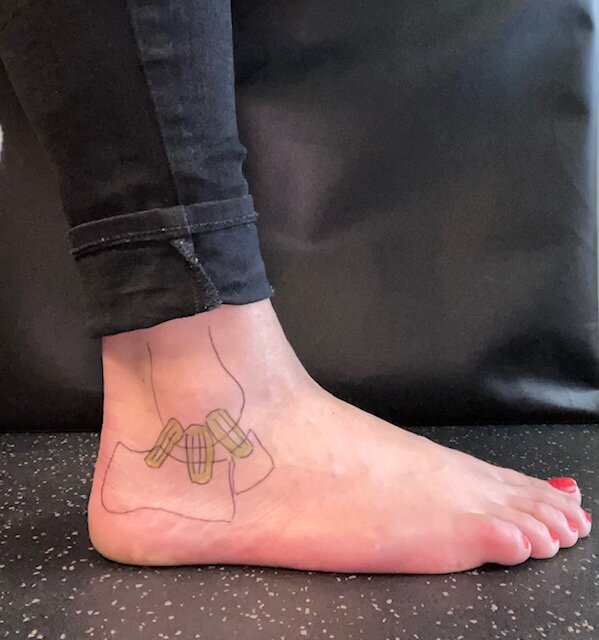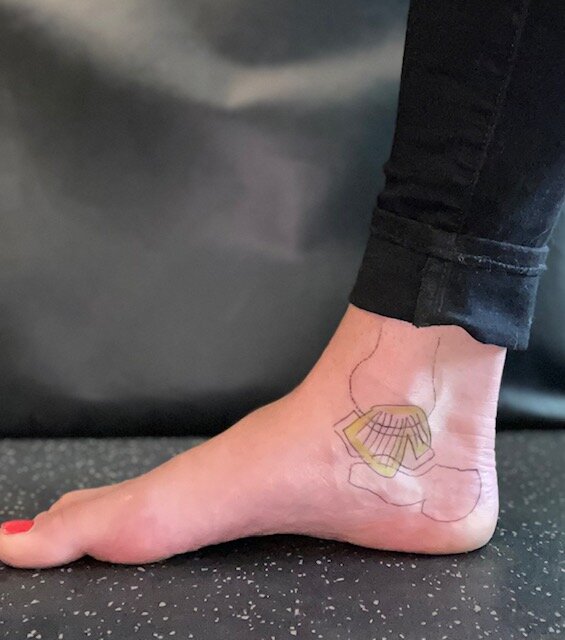Ankle sprains are one of the most common injuries in athletics with an estimated incidence of nearly 2 million people per year. Interestingly, these are some of the most neglected as far as treatment is concerned. Often, there are underlying mobility restrictions, muscle weaknesses, ligament laxity or pain that persist following an ankle injury. In this article we’re going to discuss:
Importance of a fully functional ankle to the biomechanics of the body
At Home self test for ankle function
At home exercises
Treatment we can do in the office to help you get back to 100%
Ligaments on the outside of the ankle from front to back: Anterior talofibular, calcaneofibular, and posterior talofibular
The deltoid ligaments on the inside of the ankle
Why do chronic ankle sprains happen?
It is most common for people to roll their ankle inward, which can either sprain or tear ligaments on the outer side of the ankle. Ligaments are strong, taught bands of connective tissue that connect bone to bone and provide stability to the joints. There are three main stabilizing ligaments of the outer ankle and one larger ligament of the inner ankle. With onset of a sprain to any of these ligaments, the ankle becomes painful and swells. When a joint takes on fluid and experiences pain, both become great inhibitors for muscle function and joint mobility. There are a large number of small muscles and tendons of the foot and ankle that are impacted by this onset of trauma. The muscles and tendons of the foot are important for stability in a single leg position which we assume all throughout the day with walking, jogging, climbing stairs, etc. The muscles of the ankle originate in the calf area and taper down into tendons at the inner and outer aspects of the ankle. Those are also important in single leg positions to maintain foot posture and give us stability at the foundation of the lower extremity chain. If all or any of those muscles are inhibited by this onset of trauma, they become less equipped to do their job and make an individual prone to repeat ankle sprains.
Why is it important to rehab chronic ankle sprains?
Ankle stability is important for a variety of reasons, but mainly because of our obligation as humans to be in a single leg position so frequently as we navigate our daily activities. Our ankle is one of three joints that makes up the “push off” phase of walking, jogging, sprinting, etc (along with the knee and the hip). With poor mobility or weakness in the ankle area, we shift more work into the knee and hip which can cause residual soreness or overuse injuries. The other very important part of the foot/ankle complex is its close relationship to the hip in the way of balance. If the foot does not have the strength to balance, the stabilizing muscles of the hips (glutes) don’t have the opportunity to turn on because they cannot maintain a single leg stance position. This can be a factor even in the split second we assume single leg stance in walking or jogging. Both the impaired “push off” and balance aspect of the foot/ankle can have a serious impact on our mechanics which are repeated hundreds if not thousands of times throughout our day.
At home test for ankle stability
There are two tests you can use at home to identify ankle instability and/or weakness:
Heel Raise Test:
In this test, start by standing near a stable surface so you can rest your fingers for balance. Stand on your uninvolved leg first and, keeping your knee straight, raise up onto your toes and lift the heel as high as you can. Repeat 15 times. Be sure not to be putting weight through your hands to assist. Once completed on the uninvolved leg, try on the involved side and compare pain, endurance, height of heel relative to the other side. Below is a chart of how many repetitions you should be able to achieve on a single leg based on your age as a male or female.
Single Leg Balance Test:
This is as straightforward as it sounds! Create a safe space for you to try balancing on one leg. Again, begin on your uninvolved side. Bend the non-balancing knee so that the foot elevated off the ground is behind you. Arms can come out wide to a “T”. Avoid pressing the knees or feet together to gain stability. Count the number of times your opposite foot touches the ground in a 30 second trial. Compare the number of touches side to side as well as any pain or increased difficulty you have experienced on your involved side.
At home exercises for chronic ankle sprains
Level 1
Ankle ABCs:
For ankles that are stiff or painful with daily activities, this is a great low level exercise to start some strengthening and coordination. Laying on your back with your ankle elevated. Draw the alphabet with your toes, both lowercase and uppercase. Make the letters as big as you can without pain. Repeat 2-3 times through each, daily.
Level 2:
Single leg balance:
If you don’t have pain with your daily activities or your single leg balance test, practice standing on an unstable surface like a pillow, piece of foam, or a BOSU ball if it is available for you. Stay near a stable surface so you can lightly touch the surface to help balance. Aim for 30 seconds of balance for 3-5 rounds.
Level 3:
Single leg squat:
If you are able to complete single leg balance on an unstable surface without pain and without much difficulty, work into a small single leg squat when balancing on a single leg. Use a mirror during the exercises to be sure your knee and/or ankle are not collapsing towards the midline. This will ensure that the muscles of the foot and hip are engaged. Keep the squat shallow and attempt to perform 15-20 repetitions for endurance, 2-3 sets.
Level 4:
Single leg squat clock:
Standing on a single leg, perform a small single leg squat while reaching for 12 o’clock, 3 o’clock, 6 o’clock and then reach behind for 9 o’clock. Repeat 3-5 rounds, rest and then perform again.
In office treatment for chronic ankle sprains in Boulder
Chiropractic and Physical Therapy for Ankle Sprains
If you are suffering from pain or instability in the ankle, it is likely that you need to have a full evaluation performed by our doctors to identify the weakness and/or limited mobility that triggered your symptoms. In your first appointment you will learn the cause of your symptoms, receive treatment, learn targeted exercises, and have a plan to return to pain free activity. This typically involves ankle strength, balance training, as well as hip and core stability.
Active Release Technique for Chronic Ankle Sprain
Active release technique (ART) is a non-invasive, hands-on diagnostic process of evaluating and treating musculoskeletal problems in the body. ART works by releasing tight and inflamed muscles, ligaments, tendons, and fascia after injury and overuse injuries.
ART is a fantastic tool for releasing the tension in the calf, ankle or even potentially in your hips where you may have been compensating.
Dry Needling for Chronic Ankle Sprains
Dry Needling is a technique that uses acupuncture needles to release tight, stubborn, muscles quickly. Unlike other hands on techniques, the needle can penetrate deeper into tissues to help manually release the muscle and stimulate a healing response.
If you need physical therapy for chronic ankle sprains in Boulder, Colorado - schedule an appointment today by calling or email the office.
This article was written by:
Jill Greenfield, DPT, SCS
Sports Clinical Specialist
Boulder Sports Chiropractic
3000 Center Green Dr. #130
Boulder, CO, 80301
ph: 303-444-5105




